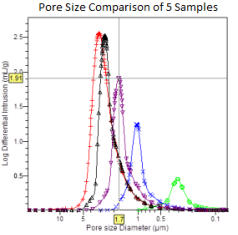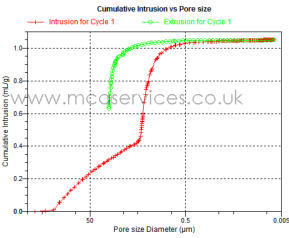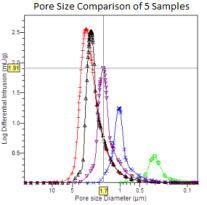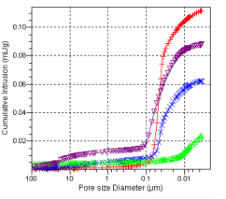




Expertise in the Physical
Characterisation of Materials

MCA Services
Unit 1A Long Barn, North End, Meldreth, Cambridgeshire SG8 6NT UK
01763 262333
© MCA Services




Mercury Porosimetry
Mercury
porosimetry
provides
a
wealth
of
information
for
the
understanding
of
any
porous
material
within
the
0.003
-
~600
micron
pore
size
range
(the
upper
limit
depends
on
the
nature
of
the
material).
The
technique
is
applicable
to
almost
any
solid
form;
we
have
decades
of
experience
in
studying
solids,
granules,
powders,
fibers
and
papers
of
a
huge
range
of
materials
from
many
industries.
Pore
size,
pore
volume
and
pore
area
often
critically
influence
the
performance,
efficiency
and
functionality
of
a
material,
for
example
in
fields
of
catalysts,
pharmaceuticals,
battery
materials
and
electrodes,
geological
specimens
etc.
Knowledge
of
porous
characteristics
is
therefore
imperative
to
the full understanding of the material and its function.
Key Information:
•
Pore size, volume and area distributions
•
Covers the pore size range of ~600 microns to 0.003 microns
•
Application to almost any solid material
•
Pore volume and pore area values
•
Average pore size by three calculations
•
Additional calculation of bulk and skeletal density
•
Additional calculation of volume porosity
•
Powerful and comprehensive reporting options and formats
•
Extension to measure permeability, tortuosity and compressibility
Mercury
porosimetry
is
an
exceptionally
powerful
technique
for
studying
materials
with
meso-
and
macro-
porosity.
Using
the
latest
Micromeritics
AutoPore
V
instrument
we
are
able
to
offer
a
comprehensive
list
of
flexible
analytical
options.
Combined
with
our
decades
of
experience,
we
are
able
to
recommend
and
tailor
analyses
to
suit
your
materials
and
their
function
as
well
as
provide
input
to
data
interpretation so that you gain the most information. More information and a demonstration is given on our
YouTube
channel.
Key Options:
•
Mercury Porosimetry Intrusion Cycle
•
Mercury Porosimetry Intrusion Cycle with Bulk & Skeletal Density and Porosity Measurement
•
Mercury Porosimetry Intrusion & Extrusion Cycles
•
Mercury Porosimetry Intrusion & Extrusion Cycles with Bulk & Skeletal Density and Porosity
Measurement (Intrusion & Extrusion Cycle)
•
Mercury Porosimetry with Permeability and Tortuosity Measurement
•
Mercury Porosimetry with Compressibility Measurement
For materials of smaller pore sizes our gas adsorption options are applicable. Alternatively, the two techniques may be combined to provide a
pore size distribution throughout the range of pore sizes. In addition to our standard reports, we can generate more specialised reports
pertinent to porosimetry analysis. For convenience the units of pore size and pore volume can be changed to include nm and Angstroms as
required. A standard set of specimen data is available on request in PDF format.







Expertise in the Physical
Characterisation of Materials
MCA Services
Unit 1A Long Barn, North End,
Meldreth, Cambridgeshire SG8 6NT UK
01763 262333
© MCA Services




Mercury Porosimetry
Mercury
porosimetry
provides
a
wealth
of
information
for
the
understanding
of
any
porous
material
within
the
0.003
-
~600
micron
pore
size
range
(the
upper
limit
depends
on
the
nature
of
the
material).
The
technique
is
applicable
to
almost
any
solid
form;
we
have
decades
of
experience
in
studying
solids,
granules,
powders,
fibers
and
papers
of
a
huge
range
of
materials
from
many
industries.
Pore
size,
pore
volume
and
pore
area
often
critically
influence
the
performance,
efficiency
and
functionality
of
a
material,
for
example
in
fields
of
catalysts,
pharmaceuticals,
battery
materials
and
electrodes,
geological
specimens
etc.
Knowledge
of
porous
characteristics
is
therefore
imperative
to
the
full
understanding
of
the
material
and
its
function.
Key Information:
•
Pore size, volume and area distributions
•
Covers the pore size range of ~600 microns to 0.003 microns
•
Application to almost any solid material
•
Pore volume and pore area values
•
Average pore size by three calculations
•
Additional calculation of bulk and skeletal density
•
Additional calculation of volume porosity
•
Powerful and comprehensive reporting options and formats
•
Extension to measure permeability, tortuosity and
compressibility
Mercury
porosimetry
is
an
exceptionally
powerful
technique
for
studying
materials
with
meso-
and
macro-
porosity.
Using
the
latest
Micromeritics
AutoPore
V
instrument
we
are
able
to
offer
a
comprehensive
list
of
flexible
analytical
options.
Combined
with
our
decades
of
experience,
we
are
able
to
recommend
and
tailor
analyses
to
suit
your
materials
and
their
function
as
well
as
provide
input
to
data
interpretation
so
that
you
gain
the
most
information.
More
information and a demonstration is given on our
YouTube
channel.
Key Options:
Mercury Porosimetry Intrusion Cycle
•
Mercury Porosimetry Intrusion Cycle with Bulk & Skeletal
Density and Porosity Measurement
•
Mercury Porosimetry Intrusion & Extrusion Cycles
•
Mercury Porosimetry Intrusion & Extrusion Cycles with Bulk &
Skeletal Density and Porosity Measurement (Intrusion &
Extrusion Cycle)
•
Mercury Porosimetry with Permeability and Tortuosity
Measurement
•
Mercury Porosimetry with Compressibility Measurement
For
materials
of
smaller
pore
sizes
our
gas
adsorption
options
are
applicable.
Alternatively,
the
two
techniques
may
be
combined
to
provide
a
pore
size
distribution
throughout
the
range
of
pore
sizes.
In
addition
to
our
standard
reports,
we
can
generate
more
specialised
reports
pertinent
to
porosimetry
analysis.
For
convenience
the
units
of
pore
size
and
pore
volume
can
be
changed
to
include
nm
and
Angstroms
as
required.
A
standard
set
of
specimen
data
is
available
on request in PDF format.




01763262333





















